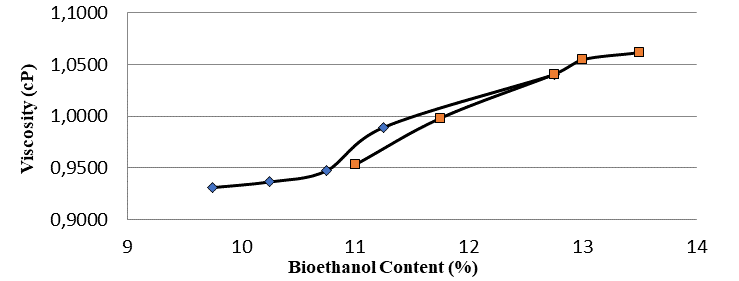Bioethanol Production from Tea Waste as a Basic Ingredient in Renewable Energy Sources
Abstract
Global demand for energy needs has increased due to the rapid development of the human population, raising the industrial prosperity in developing countries. Primary energy demand is still supplied from fossil fuels, such as oil, coal and natural gas. The utilization of fossil fuels will continuously enhance the effect of greenhouse gases in the atmosphere. On the other hand, the extent of the tea plantation area in Indonesia reached 53,009 Ha, so that it will reproduce a waste too. Thus, spent tea as bioetanol. In addition it contains cellulose fibres are quite high, environmentally friendly and economical. Bioethanol as motor vehicle fuels can reduce the addition of CO2 at atmosphere because the use of biomass for the production and usage of bioethanol can be considered as a closed cycle. According to this principle the buyer of CO2 from fuel combustion bioethanol originating from the CO2-based biomass will be reabsorbed by plants through photosynthesis reactions. As a result of this whole process is not accounted for emissions of CO2 liquid gas a greenhouse gas into the atmosphere. Bioethanol-cellulosa can reduce greenhouse gas emissions amounted to 80%. The process into products bioethanol via hydrolysis, fermentation, distillation and characterization using Gas Chromatography-Mass Spectrometry (GC-MS). Them is the optimal bioethanol levels produced from fermented inoculant 1% amounting to 8.2% and optimal levels of bioethanol produced from hydrolysis of 8% H2SO4 results amounted to 8.2%, thus optimumsitas the ethanol produced from 8% acid and 1% inoculant apply to have levels of ethanol amounted to 8.2%. The product program could be developed into bioethanol solvent to dissolve the oil that is waxy crude oil.
Full text article
References
Afdhol, M. K., Haris, F., Amiliana, R. A., Hanafi, A., & Ramadhan, I. T. (2017). Production of Activated Carbon from Coffee Grounds Using Chemical and Physical Activation Method. Advanced Science Letters, 23(6), 5751-5755.
Annual Report Statistik Perkebunan Indonesia (Teh) Tahun 2015 – 2017
Ballesteros, I., Negro, M. J., Oliva, J. M., Cabanas, A., Manzanares, P., & Ballesteros, M. (2006). Ethanol Production From Steam-Explosion Pretreated Wheat Straw, 129, 496–497.
Braide, W. (2018). Production and Spectrophotometric Quantification of Bioethanol from Pineapple Fruit Skin, 1(2), 67–74.
Gray, K. A., Zhao, L., & Emptage, M. (2012). Bioethanol. https://doi.org/10.1016/j.cbpa.2006.02.035
Johnson, L. A., & Lusas, E. W. (1983). Comparison of Alternative Solvents for Oils Extraction, 60(2), 229–242.
Koris, A., & Vatai, G. (2002). Dry degumming of vegetable oils by membrane filtration, 148, 149–153.
Mahmood, T., & Hussain, S. T. (2010). Nanobiotechnology for the production of biofuels from spent tea, 9(February), 858–868.
Millati, R., Isroi, Syamsiah, S., Niklasson, C., Cahyanto, M. N., Lundquist, K., & Taherzadeh, M. J. (2011). Biological pretreatment of lignocelluloses with white-rot fungi and its applications: a review, 6, 5224–5259.
Sarkar, N., Ghosh, S. K., Bannerjee, S., & Aikat, K. (2012). Bioethanol production from agricultural wastes : An overview. Renewable Energy, 37(1), 19–27. https://doi.org/10.1016/j.renene.2011.06.045
Tsukatani H, Tobiishi K, Imasaka T (2009). Simple and Sensitive Determination of 2, 4-Xylenol in Surface Water Samples from River and Sea by Gas Chromatography-Mass Spectrometry. Bull. Environ. Contamin. Toxicol., 82: 153–157.
Xiu, S., & Shahbazi, A. (2012). Bio-oil production and upgrading research : A review. Renewable and Sustainable Energy Reviews, 16(7), 4406–4414. https://doi.org/10.1016/j.rser.2012.04.028
Yuliusman, Afdhol, M. K., & Sanal, A. (2018). Carbon monoxide and methane adsorption of crude oil refinery using activated carbon from palm shells as biosorbent. IOP Conference Series: Materials Science and Engineering, 316, 012016. doi:10.1088/1757-899x/316/1/012016
Yuliusman, Afdhol, M. K., Sanal, A., & Nasruddin. (2018). CFD Modelling of Adsorption Behaviour in AGN Tank with Polyethylene Terephthalate Plastic Waste Based Activated Carbon. IOP Conference Series: Materials Science and Engineering, 316, 012015. doi:10.1088/1757-899x/316/1/012015
Authors
This is an open access journal which means that all content is freely available without charge to the user or his/her institution. The copyright in the text of individual articles (including research articles, opinion articles, and abstracts) is the property of their respective authors, subject to a Creative Commons CC-BY-SA licence granted to all others. JEEE allows the author(s) to hold the copyright without restrictions and allows the author to retain publishing rights without restrictions.




